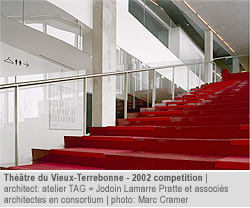Architect
A Canadian architect is a person or entity registered, licensed, or otherwise authorized exclusively to use the title “architect” and to practise architecture in a province or territory of Canada.
Architectural competition
A method of selecting a design and an architect for a sponsor's design requirements.
Competition brief
A document that includes all instructions to competitors for participating in a competition, including submission requirements and a functional program (see below).
Endorsed architectural competition
This competition includes a professional advisor, abides by a jury’s decision, is endorsed by the appropriate provincial or territorial association of architects or the RAIC, and leads to a commission for the winning architect.
A written statement which describes various criteria and data for a building project, including design objectives, site requirements and constraints, spatial requirements and relationships, building systems and equipment, and future expandability.
Invited competition
An invited competition is one in which architect eligibility is on an invitation-only basis.
Jury
The jury for an architectural competition is a body assembled to evaluate competitors’ submissions and select the winning design and other award winners based on the competition criteria.
 Limited competition
Limited competition
Limited competitions in Canada restrict the number of licensed architects who can compete and must be endorsed. Restrictions are usually geographic, namely, within Canada, a province, or a municipality.
Non-endorsed design competition
This competition is neither endorsed by the appropriate provincial or territorial association of architects nor the RAIC. It may or may not have a professional advisor or use a jury for decision-making. It may or may not lead to a commission for the winning architect.
Open competition
An open competition can be entered by any registered architect and follows the regulations of the International Union of Architects (UIA) and, therefore, is international in scope.
One-stage competition
A one-stage competition is a competition where the winning design is selected from the initial, qualifying submissions received from all registered architects who enter the competition.
Professional advisor
A professional advisor advises a sponsor and helps to administer an endorsed architectural competition. It is highly recommended that a professional advisor also be engaged for a non-endorsed design competition. A professional advisor must be an architect, registered or licensed to practice architecture in one or more Canadian provinces or territories.
Qualifications-based selection (QBS)
Qualifications-based selection (sometimes called “quality-based selection”) is a procurement process that allows an owner, client, or sponsor to choose an architect on the basis of professional qualifications and competence. The fee quotation is not a consideration in the selection process.
In the United States, the 1972 Brooks Act established QBS as the procurement process by which architects and engineers are selected for design contracts by federal design and construction agencies. In this type of related selection process (see below), contracts are negotiated on the basis of demonstrated competence and qualification for the type of professional services required at a fair and reasonable price.
The RAIC provides more online information on QBS in the Choosing an Architect section of the website.
Related selection process
In selection processes, architects are chosen by other criteria than those usually set by a competition although some elements of a competition may be included.
Sponsor (also known as Client)
The sponsor initiates and funds a competition.
Technical committee
The technical committee can be an individual or a group who assesses either the competition or submissions for a competition if the technical or budgetary requirements are unusual and/or complex.
Two-stage competition
A two stage competition is a competition where the sponsor wishes to narrow the number of registered architects who participate in the final selection process.
In the first stage, the sponsor usually requests limited design submission such as a concept design.
The sponsor chooses those architects who can compete in the second stage.



